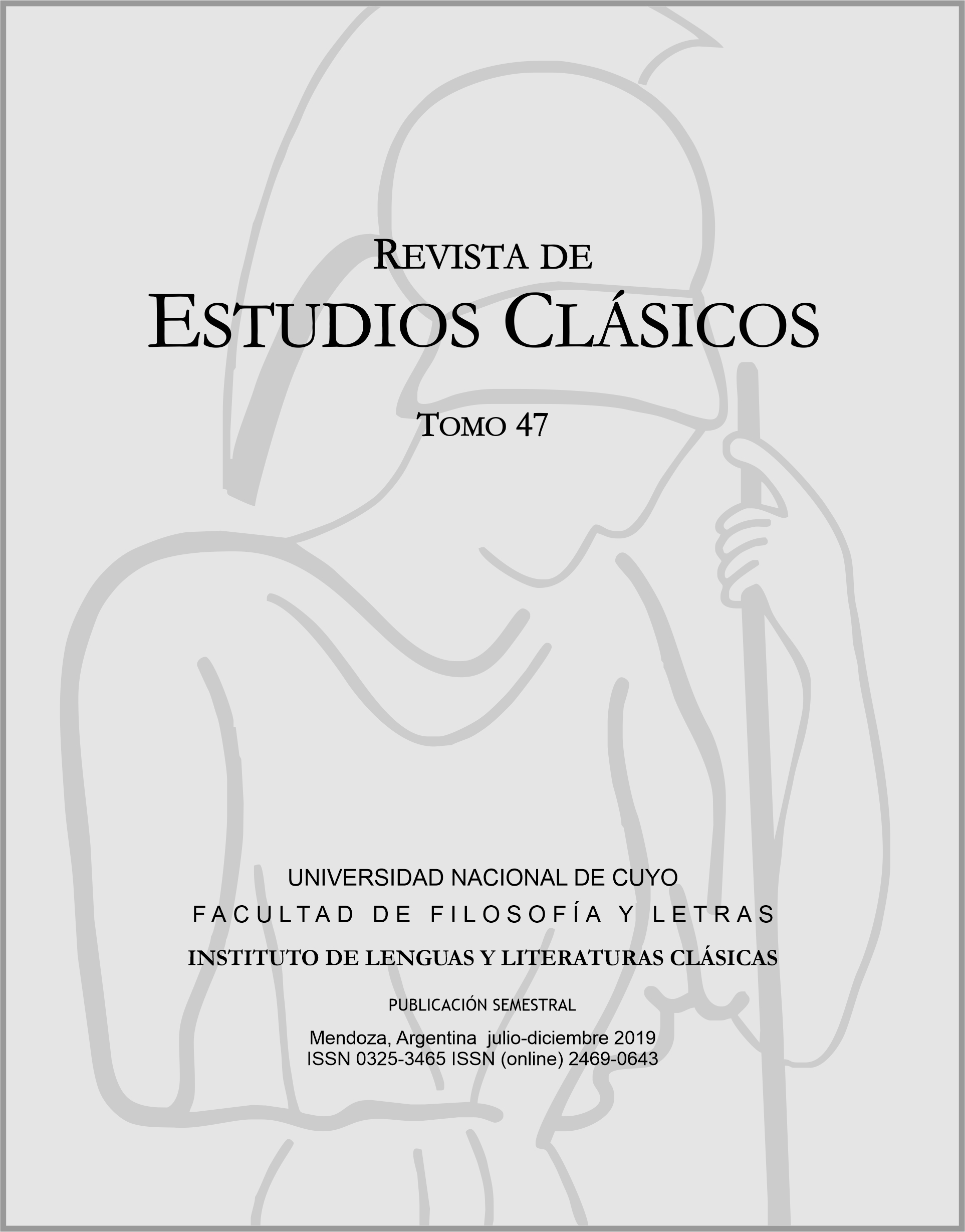Los personajes femeninos en Eneida
Acerca de la singular configuración en Hécuba en En. 2, 506-525
Palabras clave:
Eneida, personajes femeninos, Hécuba, TroyaResumen
En el marco del relato de la caída de Troya, la voz narrativa se traslada al centro del palacio de Príamo (En. 2, 506-525). Allí, la reina Hécuba amonesta a su esposo por querer vestir sus viejas armas e intentar incorporarse a la batalla. Actuar de esa manera, le dice, es obedecer a una mens dira que no se corresponde con el momento. Troya ya cayó: lo único que queda es esperar la ayuda de los dioses o morir. Este pasaje nos interesa especialmente por la configuración del personaje de Hécuba que, desde nuestro punto de vista, no responde al paradigma habitual de irracionalidad, pasión desmesurada y sufrimiento improductivo que se ha adjudicado a los personajes femeninos de Eneida (cf. Oliensis 1997, Nugent 1999, Keith 2004 y Foley 2005, entre otros).
Citas
Austin, R. G. (1964). P. Vergili Maronis Aeneidos Liber Secundus. Oxford: Clarendon Press.
Block, E. (1984). The Effects of Divine Manifestation on the Reader’s Perspective in Vergil’s Aeneid. Salem: Arno.
Bowie, A. (2008) Aeneas Narrator. PVS 26, pp. 41-51.
Foley, H. (2005) Women in Ancient Epic. En Foley, J. M. (ed.), A Companion to Ancient Epic (pp. 105-118). Oxford: Blackwell.
Fuqua, C. (1982). Hector, Sychaeus, and Deiphobus: Three Mutilated Figures in Aeneid 1-6. CPh 77.3, pp. 235-240.
Ganiban, R. T. (2012) Aeneid Books 1-6. Indianapolis: Focus.
Gransden, K. W. (1985). The Fall of Troy. G&R 32.1, pp. 60-72.
Grillo, L. (2010). Leaving Troy and Creusa: Reflections on Aeneas’ Flight. CJ 106.1, pp. 43-68.
Hallet, J. (2002). Feminae Furentes: The Frenzy of Noble Women in Vergil’s Aeneid and the Letter of Cornelia, Mother of the Gracchi. En Anderson, W. y Quartarone, L (eds.), Approaches to Teaching Vergil’s Aeneid (pp. 159-167). Nueva York: Modern Language Association of America.
Horsfall, N. (1998) Virgil, Aeneid 2. A Commentary, Leiden-Boston: Brill.
Johnson, W. R. (1999) Dis Aliter Visum: Self-Telling and Theodicy in Aeneid 2. En Perkell, C. (ed.), Reading Vergil’s Aeneid. An Interpretive Guide (pp. 50-63). Norman: University of Oklahoma Press.
Keith, A. M. (2004) Engendering Rome. Women in Latin Epic. Cambridge: Cambridge University Press.
Mitchell, R. (1991) The Violence of Virginity in the Aeneid. Arethusa 24.2, pp. 219-238.
Mynors, R. (1969) Vergili Maronis Opera. Oxford: Clarendon Press.
Nugent, S. G. (1992) Vergil’s ‘Voice of the Women’ in Aeneid V. Arethusa 25, pp. 255-292.
Nugent, S. G. (1999). The Women of the Aeneid: Vanishing Bodies, Lingering Voices. En Perkell, C. (ed.), Reading Vergil’s Aeneid. An Interpretive Guide (pp. 251-270) Norman: University of Oklahoma Press.
Oliensis, E. (1997) Sons and Lovers. Sexuality and Gender in Virgil's Poetry. En Martindale, C. (ed.), The Cambridge Companion to Virgil (pp. 294-311). Cambridge: Cambridge University Press.
O’Sullivan, T. (2009). Death ante ora parentum in Vergil’s Aeneid. TAPA 139.2, pp. 447-486.
Perkell, C. (1992). On Creusa, Dido, and the quality of victory in Virgil’s. en Foley, H. (ed.), Reflections of Women in Antiquity (pp. 355-377) Londres: Routledge.
Sklenár, R. J. (1990). The Death of Priam: Aeneid 2.506-558. Hermes 118.1, pp. 67-75.
Sullivan, J. P. (1992) Dido and the Representation of Women in Vergil’s Aeneid. En Wilhelm, R. y Jones, H. (eds.) The Two Worlds of the Poet. New Perspectives on Vergil (pp. 64-73). Detroit: Wayne State University Press.
Syed, Y. (2005) Vergil’s Aeneid and the Roman Self. Subject and Nation in the Literary Discourse. Ann Arbor: The University of Michigan Press.
Descargas
Publicado
Cómo citar
Número
Sección
Licencia
Aquellos autores/as que tengan publicaciones con esta revista, aceptan los términos siguientes:
- Los autores/as conservarán sus derechos de autor y garantizarán a la revista el derecho de primera publicación de su obra, el cuál estará simultáneamente sujeto a laLicencia Creative Commons Atribución-NoComercial-CompartirIgual 2.5 Argentina (CC BY-NC-SA 2.5 AR). (https://creativecommons.org/licenses/by-nc-sa/2.5/ar/)que permite a terceros compartir la obra siempre que se indique su autor y su primera publicación esta revista.
- Los autores/as podrán adoptar otros acuerdos de licencia no exclusiva de distribución de la versión de la obra publicada (p. ej.: depositarla en un archivo telemático institucional o publicarla en un volumen monográfico) siempre que se indique la publicación inicial en esta revista.
- Se permite y recomienda a los autores/as difundir su obra a través de Internet (p. ej.: en archivos telemáticos institucionales o en su página web) antes y durante el proceso de envío, lo cual puede producir intercambios interesantes y aumentar las citas de la obra publicada. (Véase El efecto del acceso abierto).












